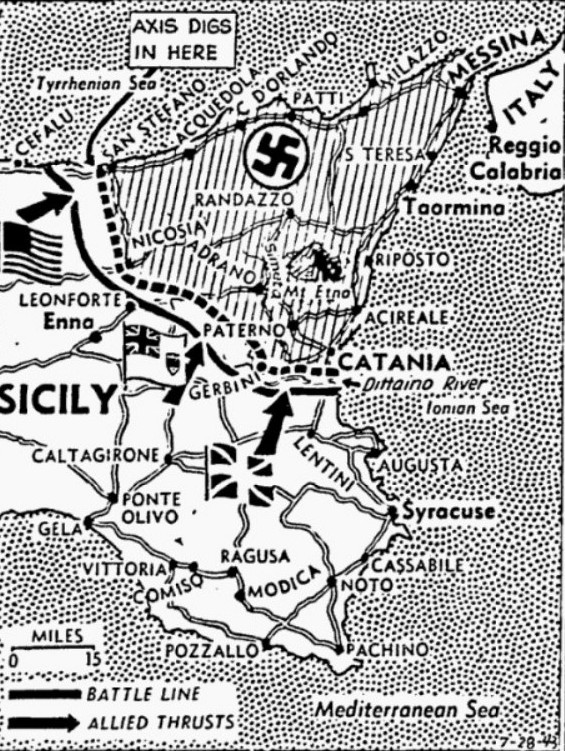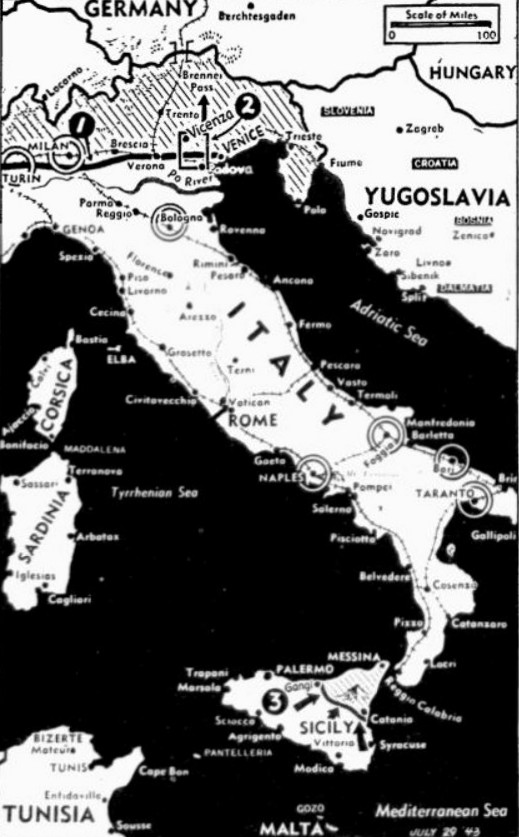The Pittsburgh Press (July 27, 1943)
Allies destroy 40 Axis planes
Troops close in on foe on tip of Sicily
By Virgil Pinkley, United Press staff writer
Allied HQ, North Africa –
Allied airmen shot down 40 Axis planes – including 21 big transports carrying troop reinforcements – over Sicily during the last 48 hours against loss of only three of their own aircraft, it was announced today.
Meanwhile, U.S. and Canadian troops, forcing the Italian and German Armies estimated at less than 100,000 men back toward the Sicilian northeastern tip, were advancing from the west and southwest, the Allied communiqué revealed.
‘According to plan’
The U.S. 7th Army racing along the northern coastal road toward Messina, was proceeding “according to plan” while the Canadian units, striking northeast from Enna, were reported to have made “limited” gains in a sharp engagement.
The London radio reported that the Americans had occupied Cefalù, midway between Termini Imerese and San Stefano on the northern coast.
The victory of British Spitfires over the lumbering German troop-carrying Ju 52s was described in a dispatch from Richard D. McMillan, United Press writer at an advanced Allied base. It was the worst beating the Axis had taken in the air since the Sicilian campaign got underway.
Sighted at dawn
A dawn patrol of Spitfires sighted the formation of transports along the northern coastline Sunday. The pilots methodically picked off the slow planes. In addition to the 21 transports, five of the escorts were shot down.
The German transports have a capacity of 20 passengers, indicating that more than 400 Axis troops may have been lost in the air battle.
Bitter fighting was reported still in progress on the southern and southwestern approaches to Catania, anchor point of the Axis defense line on the east coast.
The defense line running around Mt. Etna from below Catania to a point near Cefalù on the northern coast was being strengthened somewhat as it grew shorter, according to reports reaching headquarters. The Germans launched a counterattack yesterday but it was repelled by the Americans and Canadians. Enemy losses were heavy.
The engagement brought the Americans up against German troops after dealing mainly with Italians while completing the conquest of the western end of the island.
Nazi losses high
German losses were reported to be running as high as 400 men per battalion, or close to 50%. German reinforcements had been rushed from Messina to the fighting front, possibly indicating their distrust of the Italians
since the ouster of Premier Mussolini.
Allied medium bombers attacked railway communications at Marina di Paolo in southern Italy yesterday while light bombers and fighter bombers continued attacks on shipping in Sicilian harbors and roads on the island.
Allied fighters made offensive sweeps over Sardinia and maintained patrols over Allied shipping and land forces. The port of Milazzo was attacked by medium bombers Sunday night and torpedo-carrying planes sank an Axis merchant vessel in the Tyrrhenian Sea between Sardinia and Italy.
An Italian communiqué, broadcast by the Rome radio, said Allied planes had attacked both Naples and Messina.
Fierce final battle expected on Sicily
By Helen Kirkpatrick
Allied HQ, North Africa –
During the last 36 hours, enemy resistance in Sicily stiffened the length of the front running from the northern coast of the island to a point a few miles south of Catania with German troops making their appearance all along the line.
The growing strength of the enemy in the triangle which is all that remains to them of Sicily and the tougher opposition our advance is now meeting, suggests that the final battle for possession of the island may be a fierce one with motorized divisions and tanks playing a major role on both sides.
Railroads and roads in southern Italy and Sicily were attacked by Allied planes Sunday night and yesterday. But some mystery surrounds the destination of the Nazi transport planes encountered by the RAF near Messina. According to official reports, the Allies hold or have neutralized all the Sicilian airfields which would make it impossible for enemy aircraft to land.
But it is probable that in the Messina-Milazzo triangle they still have some fields, possibly emergency, for this purpose. Up to now it was believed that such enemy reinforcements as had reached Sicily had been transported by barges and ships from the Italian mainland or dropped by parachute as was the base of some infantry battalions sent into strengthen the Hermann Göring Division around Catania.



